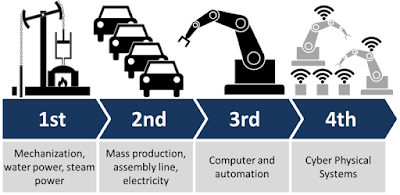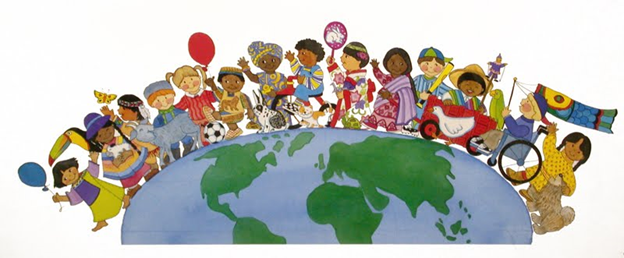Development of the Industrial Revolution
Contributor : Emir Surya
Industrial Revolution
Previously, did we know what the Industrial Revolution was? Well, the definition of the Industrial Revolution itself is simply a big and radical change in the ways of producing goods. In the history of mankind, this change has been recorded three times, and now, we are experiencing a fourth change. Every change in change must be followed by other changes in the economic, social, political, military, and even cultural fields.
For more details, we must look at every industrial revolution. But the point is the industrial revolution has made it easier for humans in the process of producing goods. What was originally difficult, old and expensive, suddenly became easy, fast, and inexpensive. Starting from industrial revolution 1.0, industrial revolution 2.0, industrial revolution 3.0 and last 4.0
First, the Industrial Revolution 1.0 began with the discovery of a steam engine by James Watt in 1776. The discovery of this steam engine was very important because before there was a steam engine, humans relied heavily on muscle power, water and wind to move anything including grinding.
The problem is the limited muscle power itself. We cannot force humans, cows, buffaloes or horses to work for 24 hours nonstop. Now there is no time limit for moving the engine. A machine can work as long as possible while supplied with enough fuel.
Because engine power is no longer limited by muscle, there are cost savings in the production, transportation, and even military processes. Humans can produce more goods than usual. Goods are easily available, anywhere and at a cheaper price.
However, there are many negative effects caused by this industrial revolution. One of them is environmental pollution due to smoke from steam engines and increasing waste from factory waste. Another impact is the occurrence of occupation throughout the world. Without a steam engine, Europeans could not conquer Asia-Africa in a fast and easy time.
The second Industrial Revolution is mass production, production lines, and the use of electricity. Muscle power has been replaced by steam, and now steam power has been replaced by electricity. But the production process in the former factories still has many weaknesses and is far from the modern word in terms of transportation. Transportation of production is still very heavy, so large items such as cars must be produced at the same place and time.
This revolution began when Ford launched the world's first inexpensive car "Ford Model T", they were flooded with orders and could not meet the target. At that time Ford was still using a production system, "one assembler of one car", this could not be maintained. The revolution occurred when Ford created the "Assembly Line" system using conveyor belts in 1913. The production process also changed completely. There is no one assembler of the car from the beginning to the end. The production process is divided into several posts as now. The use of electricity, conveyor belts and production lines is very helpful, now Ford can produce from 68 thousand cars in 1912 to 170 thousand cars in 1913.
Turning to the Industrial Revolution 3, After replacing muscle power with a steam engine, then production with a machine line, this time the human factor is replaced. The industrial revolution changed everything, the industrial age slowly began to come to an end replaced by the information age. If the revolution triggering the first revolution is a steam engine, the second is a conveyor belt with electricity, the third revolution triggered by a machine that moves using automatic power aka robots and computers.
This phenomenon began when Alan Turing, who worked for the British Government, created a machine called Collosus to decode Nazi Germany in World War II. Collosus is a large computer that does not have RAM and cannot receive commands using a keyboard like today. But the development of the computer world was very rapid after World War Two ended.
The discovery of semi conductors followed by transistors, then Integerated Chip makes the size of the computer smaller, less electricity is needed, but its capabilities are increasingly sophisticated. The size of the computer is smaller, so computers can be installed on every machine in the production line. Now computers can replace humans in the production sector only by order. This is called automation.
This also changes the socio-economic conditions in all corners of the world, starting from the agrarian sector, turning into the industrial sector, then changing into the information sector. Developed countries in America and Europe have changed a lot, from those that rely on the manufacturing sector, to become service sectors such as banks, recording studios or films, IT etc. They change their business from an industrial economy to an information economy.
Because of this progress, a lot of changes from analog data to digital data. For example, all of which use tapes to be CDs, video players to DVDs, etc. Because this is the revolution called "Digital Revolution". Because of this factor, video games including online games have become commonplace in life, and have become a business field with a turnover of trillions of rupiah. But this also has a negative side like carding, and online fraud.
Continuing to the Fourth Industrial Revolution, this concept stems from a project in the advanced technology strategy of the German government that prioritizes "factory computerization". The term 4.0 Industrial Revolution was first used at the Hanover Messe industry exhibition in the city of Hanover, Germany in 2011.
There are four main changes in the Industrial Revolution 4.0, the first is the progress of the internet that is very pronounced. At present, almost all computers are connected. Computers are also getting smaller so that they can be as big as our fists, so we have a smartphone. Second, technological advancements also created 1001 new sensors, and 1001 ways to utilize the information obtained from these sensors that record everything 24 hours a day. This information even concerns the performance of its human employees. For example, now companies can track the movements of all and every employee while in the factory.
Third, related to the first and second, is Cloud Computing. Complex calculations still require large sophisticated computers, but because they are already connected to the internet, because there is a lot of data that can be sent via the internet, all of these calculations can be done elsewhere, not at the factory.
Fourth, this is actually the biggest: Machine learning, which is a machine that has the ability to learn, who can realize that he made a mistake so he made the right correction to improve the next result. This can be illustrated by the story "AlphaZero AI". Before Machine Learning, a computer does its job "Ordered" or "Instructed" by humans.
Today we are in a historical period, the time when the fourth industrial revolution is taking place. Looking at history in the past, many major changes occurred after the industrial revolution. Millions of jobs will be replaced by new jobs too. Therefore, we must be prepared to deal with the change of change, not even avoid it. So much .....


